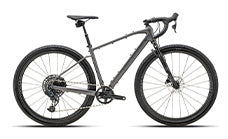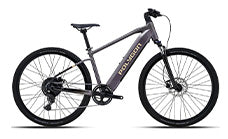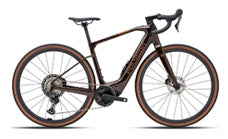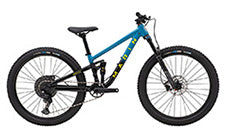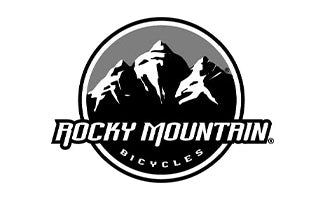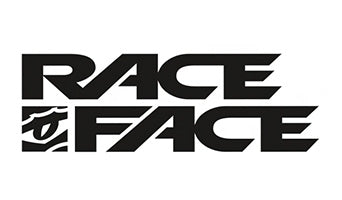Ultimate Beginner's Guide to Buying a Mountain Bike
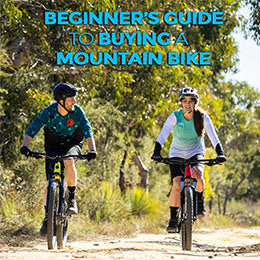

Buying your first
mountain bike
can be a daunting task.
Bicycles Online want to make the
process as easy as possible for you by narrowing down your choices. We will
look at the riding you will be doing, what bikes are best for terrains and how
to get the best bang for your buck.

What is Mountain Biking?
Mountain bikes are designed for riders looking to explore the outdoors, expand
their boundaries or challenge their limits against the clock. They are made to
be robust, comfortable and confidence-inspiring when you turn off the tarmac.
Mountain biking starts as a riding style but soon becomes a way of life as you
discover more riding destinations, go further than you could ever go on foot
or ever reach in a car. You can test your limits of speed, endurance and
riding ability or, just head out on a leisurely roll whenever you like.

Key Features
- Increased traction and comfort provided by the suspension
- Wide, Knobbly tyres that dig into the dirt
- Disc brakes for powerful and reliable braking in all conditions
- Frame geometry optimised for stability
-
Designed to take on the rough terrain and allow rider to explore with
confidence

What style of MTB should I get?
There are so many types of mountain bikes on the market these days that it is
hard to decide what suits you best. Often the best way to pick which bike will
suit you best is to identify the terrain you will be riding.

Cross Country
Cross Country bikes are designed to conquer the toughest climbs with ease, take riders to the top step at an XC race or, allow riders to travel as far as they possibly can on a ride.
They are light, stiff and leap forward with every pedal stroke. With 90-120mm of travel the efficient and nimble to ride. They love to maintain speed and propel riders along the smoother tracks with ease. When the turns get tight on the way up they turn on a dime.
While they are robust and built to take on big challenges, the lightweight
components are not always up to the task of difficult descents and may fail
when tracks get gnarly. The agile nature of these bikes on the climbs becomes
unstable on the fast downs. If you are an experienced rider you can manage to
ride XC bikes downhill with pace but, if you are a beginner they may reduce
some enjoyment on the descents.
 ;
;
Trail bikes
Trail bikes are the swiss army knives of mountain biking, designed for climbing, traversing and descending with confidence. They offer a mix of benefits from XC, All Mountain and enduro bikes, to create a bike for any style of trail.
With 120-140mm of travel and frame geometry more aimed towards speed, trail bikes are more robust to take on harder hits. They still retain some of the agility and playful traits seen in XC bikes so climbing can still be a good time.
We recommend these bikes to most beginners as they allow riders to discover
the broadest range of MTB trails. They are easy to climb and descend with
confidence. As you progress you may discover you want an XC bike to climb
faster, you may want an enduro bike that descends with more confidence or, you
could find that trail bikes suit your style perfectly.

Enduro
Enduro bikes are optimised to descend with speed while boosting a rider’s confidence. Thanks to long, low and slack geometry partnered with the 160mm+ of travel, enduro bikes love to push the boundaries.
Because these bikes are optimised for speed on the descents, climbing can be a bit of a chore. They can winch themselves up the mountain and it may take a bit more energy but, it is all worth it once you point back down.
If you are looking to ride the steep, rocky terrain with jumps and drops, an
enduro bike will have your back. They will inspire you to challenge obstacles
that once scared you and ride faster down the mountain than ever before.

Carbon Fiber
Carbon fibre is a premium material, and this is reflected in the price. Thanks
to malleable fibres, a frame's ride characteristics can be tuned throughout
the structure. Lightweight carbon fibre frames combine the best features of
Alloy and steel; they are laterally stiff while remaining vertically
compliant, resulting in excellent power delivery with insurmountable
comfort.

Alloy
Alloy mountain bikes provide the same stiffness as carbon and can be stronger when it comes to direct impacts. Alloy will also dent instead of crack, this means your bike can retain structural integrity even after a heavy hit.
Alloy Mountain bikes also offer better value because the materials are cheaper and are easily manufactured. Thanks to the lower frame cost, some alloy bikes can come with higher spec components for a better overall price. If you are tossing up between two bikes where one is a carbon frame with low specs and the other is an alloy with higher specs but they are the same price, we recommend the alloy version as it will give you a better ride.
Why should I buy a Hardtail mountain bike?

Hardtail mountain bikes offer amazing value with amazing simplicity. If you
are on a budget, want to challenge yourself or want a bike with less fuss, a
Hardtail will be perfect for you.
Thanks to the added simplicity from the lack of suspension linkages Hardtail
Mountain bikes are extremely cost-effective to manufacture. This means you can
get an excellent bike at an amazing price.

Some commuters enjoy using hardtail mountain bikes as they get extra comfort
from the larger tyres, front suspension and upright riding position. While the
bigger tyres and extra weight may make them a little less efficient on the
tarmac the comfort and durability benefits far outweigh the negatives.
Hardtail Mountain Bikes teach riders how to use their body while navigating
over difficult terrain. Beginners can learn a lot of fundamental skills from a
hardtail mountain bike. On the flip side, they can be difficult to ride for
inexperienced riders and may result in a less enjoyable ride. Riders who think
they may suffer without rear suspension should check out our dual-suspension
range.
Why should I buy a Dual Suspension mountain bike?

Dual suspension mountain bikes use linkages and rear shock absorbers to allow the rear wheel to move up and over terrain as well as the front. This leads to increased traction, stability and confidence.
Because both wheels can move up and down with the terrain your bike’s tyres
will remain in contact with the ground more constantly. The suspension will
actually compress the tyres into the ground through corners, on jumps and
through roots so you can concentrate on holding your line with confidence.

Dual suspension bikes absorb the bumps and keep your bike level as you ride
rough tracks. You won’t be getting bucked forward or get sent offline as easy,
this inspires the rider with confidence as you just point and shoot.
Riders who are new to cycling will benefit from the extra safety and control that a dual-suspension can provide. Experience riders and racers love dual-suspension bikes thanks to the extra confidence as they push their limits and increase stability at warp speed.
The only major downsides to dual suspension are added weight from the linkage
systems, some increased pedalling inefficiency from pedal bob and a larger
price tag. If you are looking for exceptional value, a lighter frame and
pedalling efficiency a hardtail will be for you.
What do the different levels of components do?

Shimano
Deore Shimano XTR
An unsung hero of mountain biking
Shimano’s flagship
mountain bike groupset, XTR,
componentry, Shimano’s Deore may
has long been
the company’s signature component suite.
be high on value, but it’s not low on quality,
In 2018, the Japanese maker released its first
performance or reliability.
12-speed iteration of this top of
the range drivetrain, the M9100,
featuring an enormous 51-tooth cassette,
along with a
range of weight-saving features.
Even before the addition
of its 12th speed XTR could be found on
the bikes of the world’s
Over the years it’s been tweaked and
fastest competitors,
claiming podium finishes
refined and has benefited from
in the biggest competitions around the globe.
improvements in technology at the higher
echelons of the Shimano hierarchy which
Lightweight, strong and stuffed with
impressive technology,
has trickled down into upgraded features
it provides some of the crispest, efficient
and consistent
for this entry-level brand. An ideal choice
gearing on the market.
on entry-level bikes and for general trail
riding.
SLX Shimano Deore XT
A relatively recent addition to the Shimano
XT brings a whole new level of performance
to the
groupset family, SLX is a highly versatile
Deore family, taking
advantage of lighter weight parts
component group that you can tailor to your
and even higher performance features. As with most
own riding preferences. SLX is a smooth-shifting,
components in the Shimano stable, XT gets trickle-down
long-lasting option packed with Shimano’s
features from the higher models in the
group, with many
high-tech features, including their Shadow+
options on offer to tailor for your
requirements – whether
rear derailleur, Ice Technology disc brakes,
you’re a trail
rider, cross-country cyclist or big-hitting
and the RapidFire plus shifter. All this adds
all-mountain type.
up to an exceptional performance at a sensible
price.
Crisper shifting, increased power transfer and general
refinement are where XT
excels.
SRAM
SRAM SX Eagle SRAM GX Eagle
The SX Eagle uses similar technology
GX
Eagle was the first affordable bridge to 50t-speed from SRAM
to some of SRAM’s higher-end groupsets
and quickly became one
of their most popular as a result.
but the SX is at a much lower price point.
Using much of the
technology from the top end
Although on the lowest rung of the Eagle
groupsets
without some of the weight-saving advantages of the
drivetrain lineup it still shares technologies
XX1 and X01, GX is a
reliable, high-performance groupset worthy
most obviously the largest 50T sprocket cassette.
of its place on any bike.
The SX Eagle is a more common sight on
complete bikes.
SRAM said their Eagle drivetrains are designed to
work as complete systems, giving riders the ability to
interchange XX1, X01, GX, or NX Eagle components
as they desire.
SRAM NX Eagle SRAM X01 Eagle
NX Eagle shares technologies with its higher-end
Released in 2017, SRAM X01 Eagle swooped to popular
acclaim
birds of a feather, making it completely compatible
with its tight response, reliability, and sensational
performance.
within the Eagle component ecosystem – good
news for Eagle riders looking to replace parts for
less.
SRAM GX EAGLE AXS SRAM XX1 EAGLE
When SRAM released their high-end XX1 and XO1
The original and still the gold standard, the SRAM
XX1
wireless drivetrains, not only were we excited by the
Eagle is the envy of riders everywhere with
its gleaming
new technology but possibly more interesting that it
golden chain and cassette. Initially conceived with cross-
wouldn’t be too long until that technology worked its
country riding in mind, the XX1 Eagle offers incredible
way down to SRAM’s more affordable drivetrains.
shifting quality in the toughest settings.
GX Eagle AXS is the perfect example of trickle-down
technology – the performance on offer with GX Eagle
AXS is so close to the top end systems that many people
will be wondering why they should spend more.
The Upgrade Kit comes with a rear derailleur, battery,
controller with clamp, charger and chain gap tool – which is
everything you need to take your wired SRAM Eagle system
to the next level, without having to splash out on a fresh groupset.
Finding Balance

We would all love to start riding the best superbike possible, but we know
that is not possible for everyone. The best bike may also be overwhelming for
many new riders due to the insane amount of adjustment and technology.
When you are on a budget, we recommend aiming to get the bike closest to your
maximum amount. Bikes represent a more effective product for the more you pay.
Settling for a lower price can often mean you are settling for a lower grade
product.

If you are looking at riding extremely rough terrain a lot of the time, a bike that isn't up to the challenge will end up costing you more over the long run. You want to be riding your bike, not repairing it all the time. Spending the extra money at the start will save you money in the long run.
While Bicycles Online offers the best bikes for the best value, we still
understand that balancing your budget with the bike you want is hard. When you
are sitting at your desk wondering which model you want to get, we highly
recommend doing so if you can stretch the budget and get a better bike.
Sacrificing higher-end components to save some money at the start will only
hurt your wallet in the long run. Get on the best bike now and enjoy the
ride.














